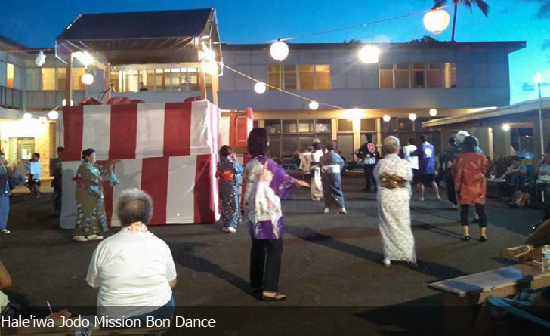As the days grow longer and summer quickly approaches, people from all over the island flock to the North Shore for activities suited for long and hot days. The stunning beaches, rich cultural history, and refreshing shave ice are just a few reasons to visit this part of Hawai‘i. There are, of course, many other reasons to visit, like Hale‘iwa Jodo Mission’s bon dance and toro nagashi.
The Hale‘iwa Jodo Mission is a Buddist temple located just west of Ali‘i Beach Park. Founded more than a century ago in May 1912, by Reverend Jitsujyo Muroyama, the Mission moved to its current location in 1913, to the old Hale‘iwa Seaside Hotel building and surrounding land. The temple is well-known in the community for its history as a Japanese school as well as for hosting events such as bon dances and craft fairs.
Many people are familiar with the bon dance tradition in Hawai‘i, but not everyone knows its origins. Originating in Japan, Obon is a Buddhist custom to honor the spirits of one’s ancestors. This tradition consists of families coming together to clean family graves and household altars, as the spirits of their ancestors are believed to come back to visit for a brief time. Celebrated in Japan for more than 600 years, the bon dance is a folk entertainment and genre of dance performed during this Obon period.
The different flavors of the various regions of Japan can be experienced in the different styles of dances and songs throughout the island chain. Over time, the religious connotations of the bon dance have faded and, for many, it is now thought of more as a summer activity, like a carnival.
Bon dances are often performed with lines of people forming a circle around a high, wooden scaffold called a yagura. The musicians and singers often perform on the yagura, while the people dance around it. The modern-day Bon Dance is beloved by many because it is a fun experience for people of all ages. The Hale‘iwa Bon Dance, which is usually held on a Friday and Saturday evening during the summer, has the traditional yagura and dancing, great food, and refreshing, delicious shave ice. It also has the ever-popular Fukushima Ondo accompanied by a live taiko group.
Alongside this tradition, on the second evening of the Hale‘iwa Jodo Mission bon dance, there is usually a toro nagashi, or floating-lantern ceremony. Hundreds of people gather around to release over a thousand
paper lanterns directly into the ocean and watch the spectacle. The sight of the lanterns slowly fading away into the dark is both graceful and mesmerizing. This Japanese custom became widescale after 1946, when people started setting lanterns afloat to honor the victims of the atomic bombings of Japan and other lives lost during WWll. By writing the names of ancestors or loved ones who have passed onto each lantern, it is not only a way to honor them, but also a way to help guide their spirits on their journeys back to their permanent dwelling places in the Pure Land. A few years ago, the Hale‘iwa Jodo Mission switched to multi-colored lanterns, which were more earthfriendly, which makes for a cleaner ocean as well as a more colorful light show.
Due to coronavirus concerns, many of the summer O-Bon events across Hawai‘i have unfortunately been cancelled, including the Hale‘iwa Jodo Mission Bon Dance and Toro Nagashi. However, the temple is still planning to observe some rituals during Obon such as Otoba (a ritual that involves praying for the deceased, whose names have been written on long wooden planks symbolizing stupas). Please look up the Hale‘iwa Jodo Mission – Buddhist Temple on Facebook, for more information.



